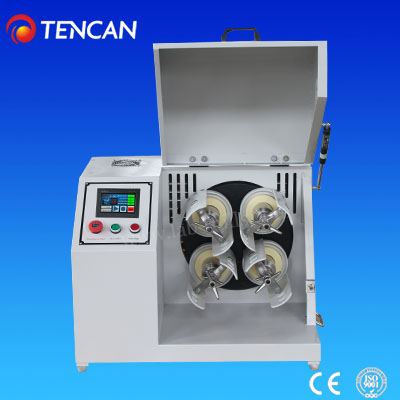Understanding the Critical Speed in Planetary Ball Milling: A Balancing Act for Optimal Grinding
Planetary ball mills are workhorses in material processing, achieving exceptional grinding results through a unique combination of rotation and impact forces. However, a crucial concept plays a major role in their efficiency: critical speed.
 The Importance of Critical Speed
Critical speed (CS) refers to the theoretical rotational speed at which the grinding media within a planetary ball mill would be pinned against the mill wall due to centrifugal force. At this speed, no grinding would occur, as the media wouldn't be cascading and impacting the material within the grinding vial.
The formula for critical speed is:
CS = 1 / (2π√(g / (R - r)))
Where:
CS = Critical speed (in revolutions per minute, RPM)
g = Gravitational constant (m/s²)
R = Inner radius of the mill shell (m)
r = Radius of a grinding media ball (m)
Why Critical Speed Matters
Planetary ball mills operate at speeds below the critical speed. Here's why:
Optimal Grinding Efficiency: Operating below CS allows the grinding media to cascade within the vial, impacting the material and achieving efficient grinding.
Minimizing Media Wear: At speeds exceeding CS, the media would constantly rub against the mill wall, leading to excessive wear and potential contamination of the sample.
The Importance of Critical Speed
Critical speed (CS) refers to the theoretical rotational speed at which the grinding media within a planetary ball mill would be pinned against the mill wall due to centrifugal force. At this speed, no grinding would occur, as the media wouldn't be cascading and impacting the material within the grinding vial.
The formula for critical speed is:
CS = 1 / (2π√(g / (R - r)))
Where:
CS = Critical speed (in revolutions per minute, RPM)
g = Gravitational constant (m/s²)
R = Inner radius of the mill shell (m)
r = Radius of a grinding media ball (m)
Why Critical Speed Matters
Planetary ball mills operate at speeds below the critical speed. Here's why:
Optimal Grinding Efficiency: Operating below CS allows the grinding media to cascade within the vial, impacting the material and achieving efficient grinding.
Minimizing Media Wear: At speeds exceeding CS, the media would constantly rub against the mill wall, leading to excessive wear and potential contamination of the sample.
 Safety Considerations: Operating at or above CS could pose safety risks due to excessive stress on the mill components.
Operating Speeds and Percent of Critical Speed
Planetary ball mills typically operate at a percentage of their critical speed, often ranging from 50% to 70%. Here's a breakdown of what these percentages represent:
50-60% CS: This range is often considered ideal for many applications, offering a good balance between grinding efficiency and minimizing media wear.
60-70% CS: This range can be suitable for achieving finer particle sizes, but close monitoring is necessary to avoid excessive media wear.
Below 50% CS: Operating too far below CS can lead to longer grinding times and potentially lower grinding efficiency.
Factors Affecting Critical Speed
Several factors influence a planetary ball mill's critical speed:
Mill Size: Larger mills with a bigger inner radius (R) will have a lower critical speed compared to smaller mills.
Grinding Media Size: The radius (r) of the grinding media balls plays a role. Larger media results in a higher critical speed.
Material Properties: The density of the grinding media and the material being processed can slightly influence the critical speed calculation.
Conclusion
Understanding critical speed is essential for operating planetary ball mills effectively. By keeping the operating speed below CS and selecting an appropriate percentage based on your application, you can achieve optimal grinding efficiency, minimize media wear, and ensure safe operation of your mill. Remember, consulting your mill's manual and experimenting with different parameters within recommended ranges is crucial for fine-tuning the process for your specific needs.
Safety Considerations: Operating at or above CS could pose safety risks due to excessive stress on the mill components.
Operating Speeds and Percent of Critical Speed
Planetary ball mills typically operate at a percentage of their critical speed, often ranging from 50% to 70%. Here's a breakdown of what these percentages represent:
50-60% CS: This range is often considered ideal for many applications, offering a good balance between grinding efficiency and minimizing media wear.
60-70% CS: This range can be suitable for achieving finer particle sizes, but close monitoring is necessary to avoid excessive media wear.
Below 50% CS: Operating too far below CS can lead to longer grinding times and potentially lower grinding efficiency.
Factors Affecting Critical Speed
Several factors influence a planetary ball mill's critical speed:
Mill Size: Larger mills with a bigger inner radius (R) will have a lower critical speed compared to smaller mills.
Grinding Media Size: The radius (r) of the grinding media balls plays a role. Larger media results in a higher critical speed.
Material Properties: The density of the grinding media and the material being processed can slightly influence the critical speed calculation.
Conclusion
Understanding critical speed is essential for operating planetary ball mills effectively. By keeping the operating speed below CS and selecting an appropriate percentage based on your application, you can achieve optimal grinding efficiency, minimize media wear, and ensure safe operation of your mill. Remember, consulting your mill's manual and experimenting with different parameters within recommended ranges is crucial for fine-tuning the process for your specific needs.
